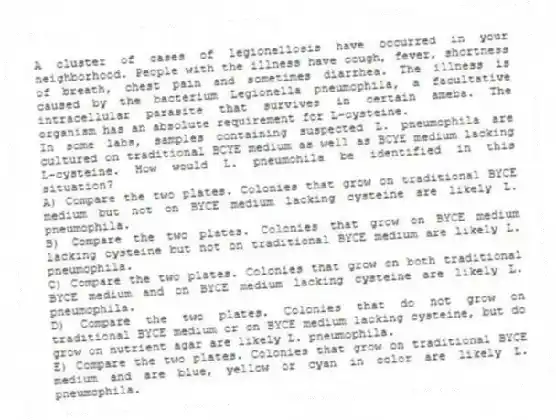
A cluster of cases of legionellosis have occurred in your neighborhood. People with the illness have cough, fever, shortness of breath, chest pain and sometimes diarrhea. The illness is caused by the bacterium Legionella pneumophila, a facultative intracellular parasite that survives in certain ameba. The organism has an absolute requirement for L-cysteine.
-In some labs, samples containing suspected L. pneumophila are cultured on traditional BCYE medium as well as BCYE medium lacking L-cysteine. How would L. pneumohila be identified in this situation?
A) Compare the two plates. Colonies that grow on traditional BYCE medium but not on BYCE medium lacking cysteine are likely L. pneumophila.
B) Compare the two plates. Colonies that grow on BYCE medium lacking cysteine but not on traditional BYCE medium are likely L. pneumophila.
C) Compare the two plates. Colonies that grow on both traditional BYCE medium and on BYCE medium lacking cysteine are likely L. pneumophila.
D) Compare the two plates. Colonies that do not grow on traditional BYCE medium or on BYCE medium lacking cysteine, but do grow on nutrient agar are likely L. pneumophila.
E) Compare the two plates. Colonies that grow on traditional BYCE medium and are blue, yellow or cyan in color are likely L. pneumophila.
Correct Answer:
Verified
Q71: You are in charge of water quality
Q72: Shigella species and Salmonella species are classified as
Q73: Eosin methylene blue agar (EMB) is a
Q74: Mrs. Thomas comes to the emergency department
Q75: You are culturing a new bacterium in
Q76: A cluster of cases of legionellosis have
Q77: You take absorbance readings on a spectrophotometer
Q79: Mr. Jones comes to your clinic complaining
Q80: Mrs. Thomas comes to the emergency department
Q81: A cluster of cases of legionellosis have
Unlock this Answer For Free Now!
View this answer and more for free by performing one of the following actions

Scan the QR code to install the App and get 2 free unlocks

Unlock quizzes for free by uploading documents